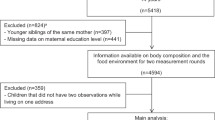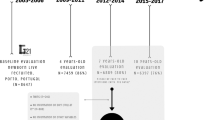Abstract
OBJECTIVE: To determine if the source from which food is obtained has contributed to the increased obesity of the US population, while controlling for demographic, lifestyle and regional factors.
METHODS: Multiple regression was used to estimate the effect of food source on body mass index (BMI) while accounting for other factors which have been shown to affect obesity in a nationally representative sample of the US population.
SAMPLE: This study used secondary data from the 1994–1996 Continuing Survey of Food Intake by Individuals (CSFII). The CSFII is a nationally representative sample of 16,103 individuals, obtaining for each respondent 24 h recalls of all food intake on two nonconsecutive days as well as demographics and information on lifestyle choices.
RESULTS: For a large number of demographic and lifestyle factors, our results support those which have previously been found to contribute to increased overweight. Our contribution is to examine whether the source from which food is obtained also contributes to increased overweight. Our evidence suggests that this is the case. The average height for males in our sample was 1.77 m. For two such males, one who ate food away from home (FAFH) during the previous 24 h period and the other who did not, results suggest that the first will be about 1 kg heavier, all other factors being equal. For two females of average height (1.63 m) the same is true for those who ate fast food, but not at restaurants. In all cases, except females who ate at restaurants, the effects are significant in the regression (P<0.05).
CONCLUSION: The trends in both increased US obesity and in increased consumption of FAFH are unlikely to be coincidental. FAFH, and particularly fast food consumption, are likely to be contributing factors to increased obesity.
This is a preview of subscription content, access via your institution
Access options
Subscribe to this journal
Receive 12 print issues and online access
$259.00 per year
only $21.58 per issue
Buy this article
- Purchase on Springer Link
- Instant access to full article PDF
Prices may be subject to local taxes which are calculated during checkout
Similar content being viewed by others
References
Federation of American Societies for Experimental Biology Life Sciences Research Office (FASEBLS) . Third report on nutrition monitoring in the United States; Volume I. Prepared for the Interagency Board for Nutrition Monitoring and Related Research. US Government Printing Office: Washington, DC 1995.
Galuska D, Serdula M, Pamuk E, Siegel P, Byers T . Trends in overweight among US adults from 1987 to 1993: a multistate telephone survey Am J Public Health 1996 86: 1729–1735.
Kuczmarski R, Flegal K, Campbell S, Johnson C . Increasing prevalence of overweight among US adults JAMA 1994 272: 205–211.
National Center for Chronic Disease Prevention and Health Promotion, Behavioral Surveillance Branch, Centers for Disease Control . Behavioral Risk Factor Survey Surveillance System. CD-Rom, Series 1, No. 1, 1984–1995.
Wolf AM, Coldita GA . The cost of obesity: the US perspective Pharmoeconomics 1994 5: 37.
National Center for Health Statistics, Center for Disease Control . BRFS summary report. Atlanta, GA, Various years.
Putnam JJ, Allshouse JE . Food consumption, prices and expenditures, 1970–97. Food and Rural Economics Division, Economic Research Service, US Department of Agriculture. Statistical Bulletin no. 965, April 1999.
Lin BH, Frazão E, Guthrie J . Away-from-home foods increasingly important to quality of American diet. Agriculture Information Bulletin no. 749.
Finke M, Tweeten L, Chern W . Economic impact of proper diets on farm and marketing resources Agribusiness 1996 12: 201–207.
Rose D . Attitudes and behaviors related to weight status Food Rev 1994 17: 30–35.
Bray GA, Popkin BM . Dietary fat intake does affect obesity! Am J Clin Nutr 1998 68: 1157–1173.
USA Today (20 February 1996).
Cortez R, Senauer B . Taste changes in the demand for food by demographic groups in the United States: a nonparametric empirical analysis Am J Agric Econom 1996 78: 280–289.
Kinsey J . Working wives and the marginal propensity to consume food away from home Am J Agric Econ 1983 65: 10–19.
Lee J, Brown M . Food expenditures at home and away from home in the United States: a switching regression analysis Rev Econom Stat 1986 68: 142–147.
Park JL, Holcomb RB, Raper KC, Capps O Jr . Demand systems analysis of food commodities by US households segemented by income Am J Agric Econom 1996 78: 290–300.
Prochaska FJ, Schrimper RA . Opportunity cost and other socioeconomic effects on away-from home food consumption Am J Agric Econom 1973 55: 595–603.
Redman BJ . The impact of women's time allocation on expenditure for meals away from home and prepared foods Am J Agric Econ 1980 62: 234–237.
Sexauer B . The effect of demographic shifts and changes in the income distribution on food-away-from-home expenditure Am J Agric Econ 1979 61: 1046–1057.
Yen ST . Working wives and food away from home: the Box–Cox double hurdle model Am J Agric Econ 1993 75: 884–895.
US Department of Agriculture, Agricultural Research Service . 1994–96 continuing survey of food intakes by individuals and 1994–96 diet and health knowledge survey. CD-Rom. Available from National Technical Information Service, Springfield, VA, 1998.
Tippett KS, Cypel YS (eds) . Design and operation: the continuing survey of food intakes by individuals and the diet and health knowledge survey 1994–1996. US Department of Agriculture, Agricultural Research Service, Continuing Survey of Food Intakes by Individuals 1994–1996, Nationwide Food Surveys Report no. 96–1, 1997. [Available at: http://sun.ars-grin.gov/ars/Beltsville/barc/bhnrc/foodsurvey/pdf/Dor9496.pdf.]
Greene WH . Econometric Analysis, 4th edn. Prentice-Hall: Upper Saddle River, NH, 2000.
Tucker LA, Friedman GM . Television viewing and obesity in adult males Am J Public Health 1989 79: 516–518.
Tucker LA, Bagwell M . Television viewing and obesity in adult females Am J Public Health 1991 81: 908–911.
Bureau of Labor Statistics, US Bureau of the Census . 1992 census of retail trade: state summaries and special subjects. Washington, DC, 1995.
Jeffery RW, French SA . Epidemic obesity in the United States: are fast food and television viewing contributing? Am J Public Health 1998 88: 277–280.
Cairney J, Wade TJ . Correlates of body weight in the 1994 National Population Health Survey Int J Obes Relat Metab Disord 1998 22: 584–591.
Flegal KM, Harlan WR, Landis JR . Secular trends in body mass index and skinfold thickness with socioeconomic factors in young adult women Am J Clin Nutr 1988 48: 535–543.
Stern M, Pugh, J, Gaskill S, Hazuda H . Knowledge, attitudes, and behavior related to obesity and dieting in Mexican Americans and Anglos: the San Antonio Heart Study Am J Epidemiol 1982 115: 917–928.
Pomerleau J, McKeigue PM, Chaturvedi N . Factors associated with obesity in South Asian, Afro-Caribbean and European women Int J Obes Relat Metab Disord 1999 23: 25–33.
Cairney J, Ostbye T . Time since immigration and excess body weight Can J Public Health—Rev Can Sante Publique 1999 90: 120–124.
Winkleby M, Fortmann S, Barrett D . Social class disparities in risk factors for disease: eight-year prevalence patterns by level of education Prev Med 1990 19: 1–12.
Rimm I, Rimm A . Association between socioeconomic status and obesity in 59,556 women Prev Med 1974 3: 543–572.
Sobal J, Stuckard AJ . Socioeconomic status and obesity: a review of the literature Psychol Bull 1989 105: 260–275.
Jeffery R, French S . Socioeconomic status and weight control practices among 20- to 45-year-old women Am J Public Health 1996 86: 1005–1010.
Coakley EH, Rimm EB, Colditz G, Kawachi I, Willett W . Predictors of weight change in men: results from the Health Professionals Follow-Up Study Int J Obes Relat Metab Disord 1998 22: 89–96.
Crawford DA, Jeffery RW, French SA . Television viewing, physical inactivity and obesity Int J Obes Relat Metab Disord 1999 23: 437–440.
Shah M, Hannan PJ, Jeffrey RW . Secular trend in body mass index in the adult population of three communities from the upper mid-western part of the USA: the Minnesota Heart Health Program Int J Obes 1991 15: 499–503.
Author information
Authors and Affiliations
Corresponding author
Rights and permissions
About this article
Cite this article
Binkley, J., Eales, J. & Jekanowski, M. The relation between dietary change and rising US obesity. Int J Obes 24, 1032–1039 (2000). https://doi.org/10.1038/sj.ijo.0801356
Received:
Revised:
Accepted:
Published:
Issue Date:
DOI: https://doi.org/10.1038/sj.ijo.0801356
Keywords
This article is cited by
-
Association of Alcohol Use and Physical Activity with Body Mass Index in Mexican-Origin Adults
Journal of Racial and Ethnic Health Disparities (2022)
-
The association of change in physical activity and body weight in the regulation of total energy expenditure
European Journal of Clinical Nutrition (2017)
-
Integrating expert knowledge in a GIS to optimize siting decisions for small-scale healthy food retail interventions
International Journal of Health Geographics (2016)
-
Maternal employment and food produced at home: evidence from Japanese data
Review of Economics of the Household (2016)
-
Leading the consumer by the nose: on the commercialization of olfactory design for the food and beverage sector
Flavour (2015)



